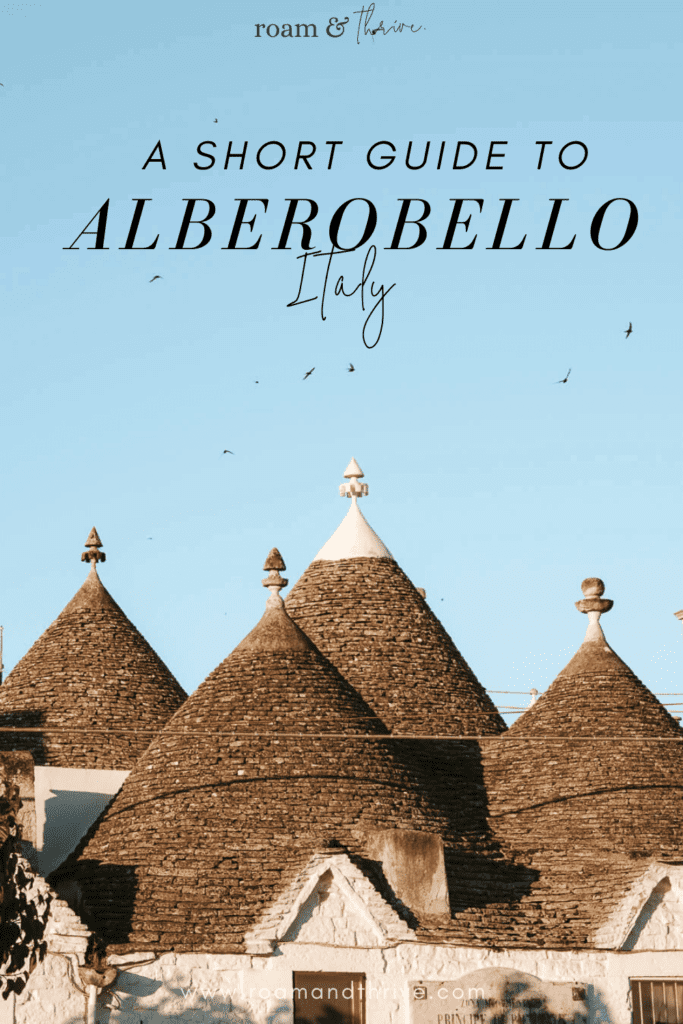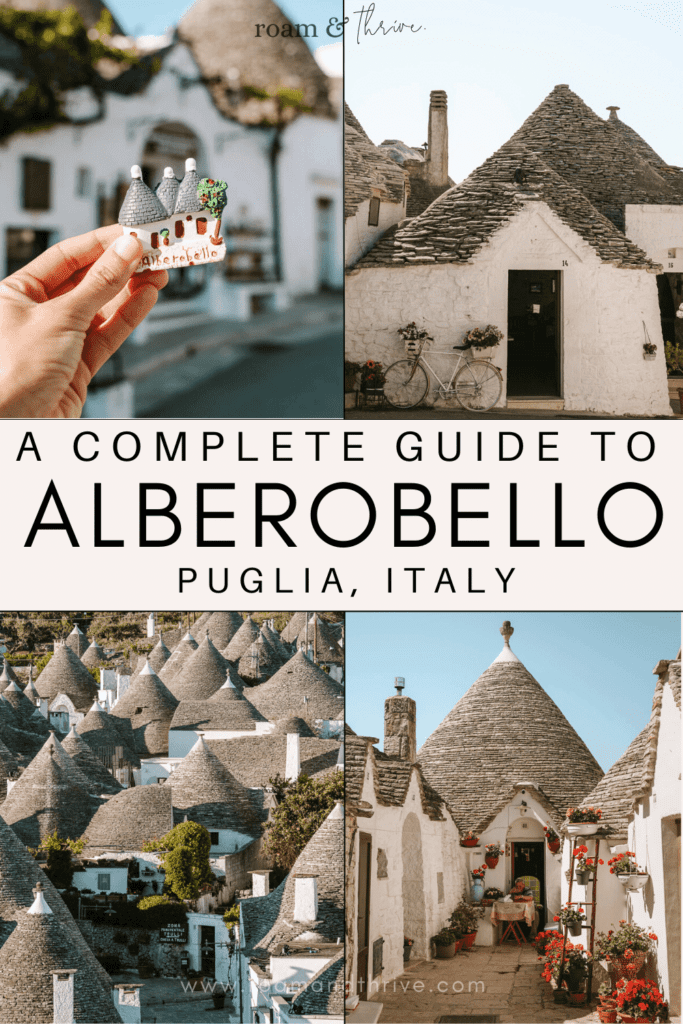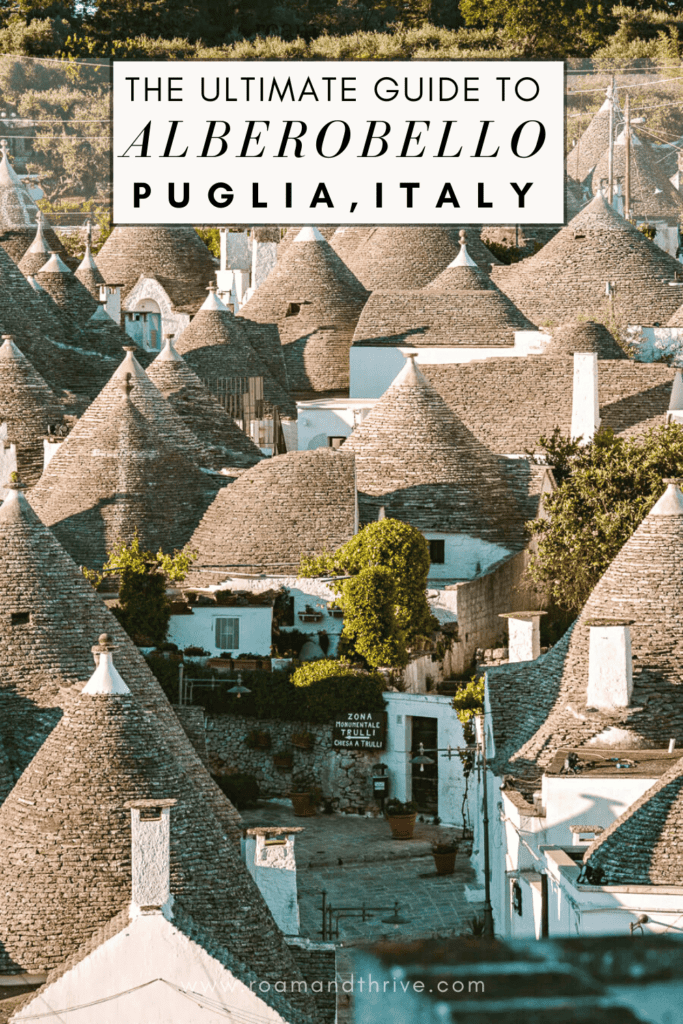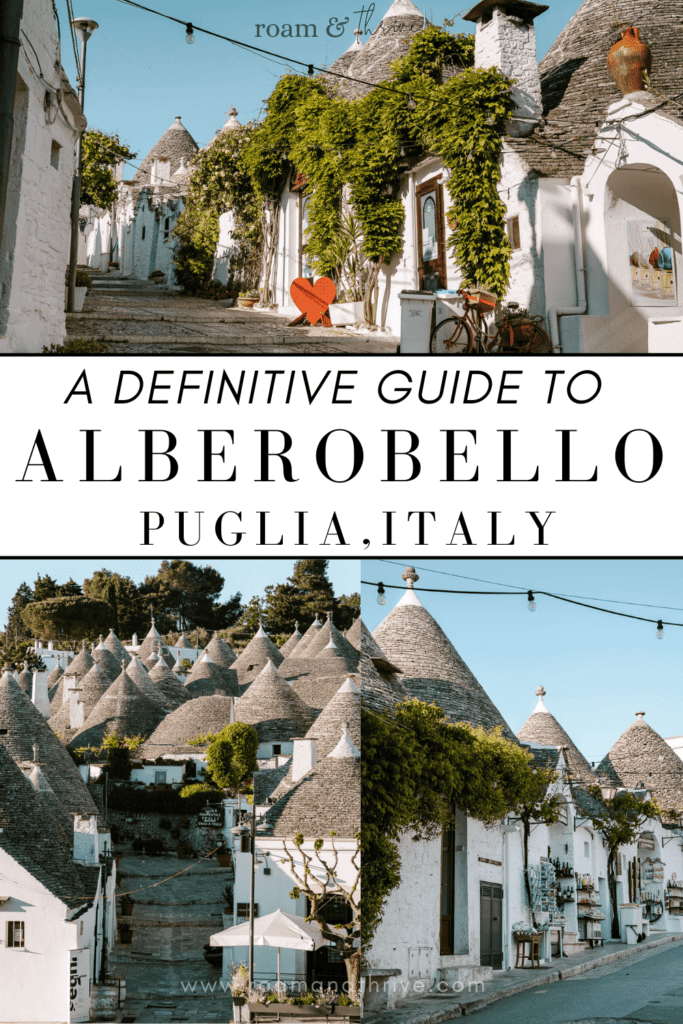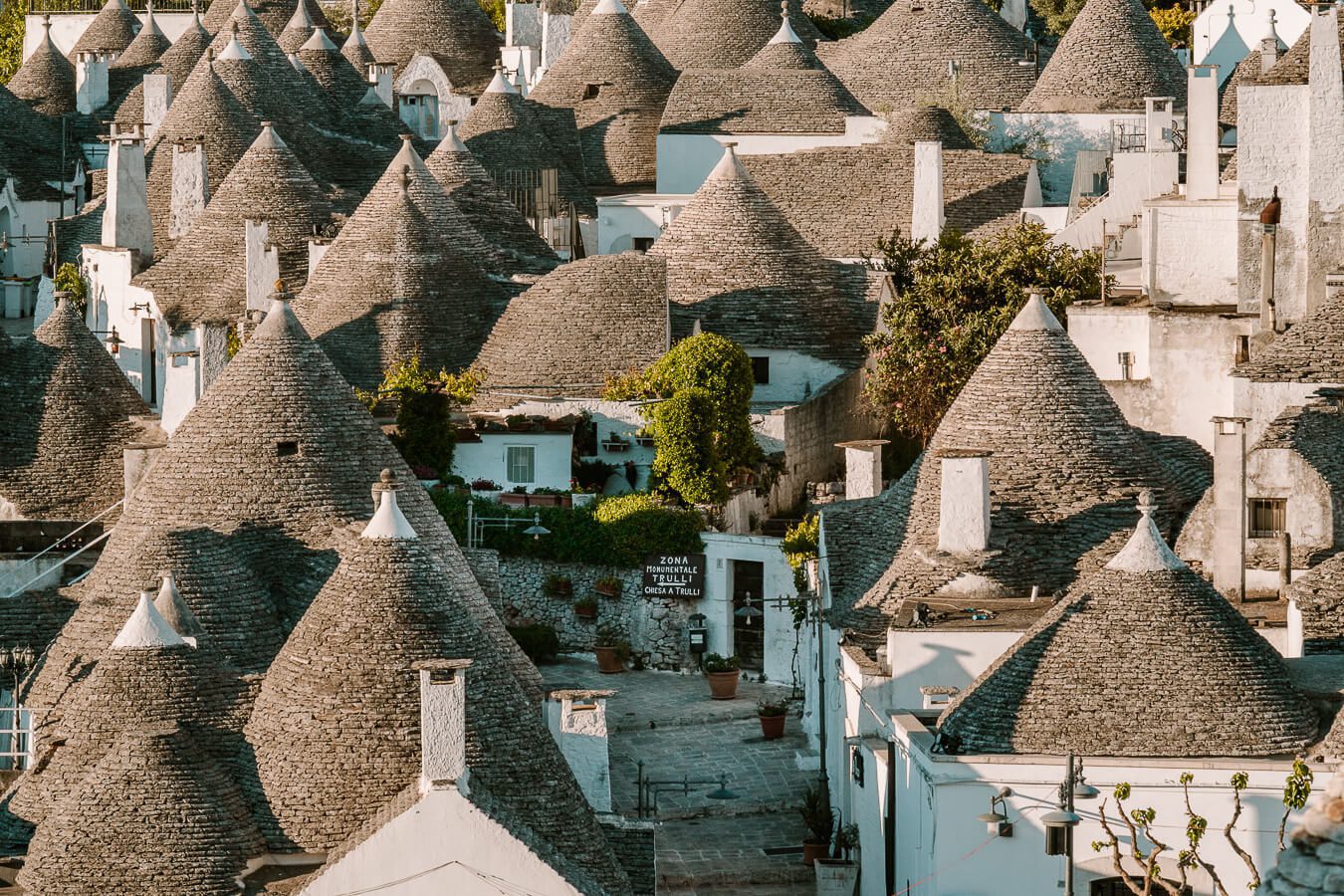
The Best Things to Do in Alberobello, Italy
Discover Alberobello Italy, Puglia’s most famous small town with its trulli. Keep reading for our mini Alberobello guide for everything you need to know before visiting and the best things to do in Alberobello.
When someone mentions Puglia, there’ll be practically no time until they start talking about Alberobello.
Alberobello is probably Puglia’s most popular and most visited town famous for its trulli (singular, trullo), one-of-a-kind stone buildings with conical roofs.
A visit to Alberobello will have you exploring the trulli-lined streets, peeking into the structures themselves and perhaps dining in one or two trullo restaurants and cafes.
I live in Puglia and have visited Alberobello several times throughout the last few years. Keep reading to find the best things to do in Alberobello Italy
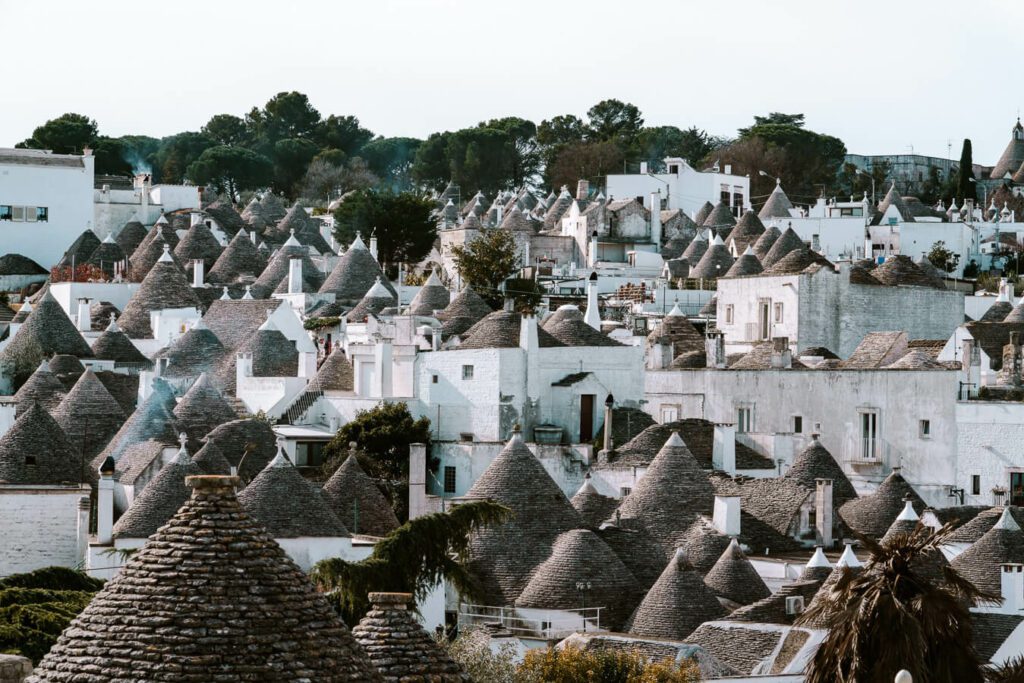
The trulli have a fascinating history connected to the ruling powers of the area in the 15th Century.
In the 15th Century, most of modern-day Puglia was subjected to the rules and laws of the Kingdom of Naples that subjected various settlements to tributes (in the form of taxes).
At this time Alberobello was in the feudal hands of the Counts of Conversano D’Acquaviva D’Aragona who ordered the town’s residents to build their homes using dry stone- without using mortar.
This would give them a precarious and unfinished state so they could easily be demolished to avoid tributes having to be paid to the Kingdom of Naples.
With some trial and error, the residents found that this single, conical roofed dwelling was the best structure. Low and behold, the trullo was born.
Throughout the years, residents continued living in these buildings, eventually adding mortar to make them safer and more permanent structures. The trulli of Alberobello were declared a UNESCO World Heritage Site in 1996.
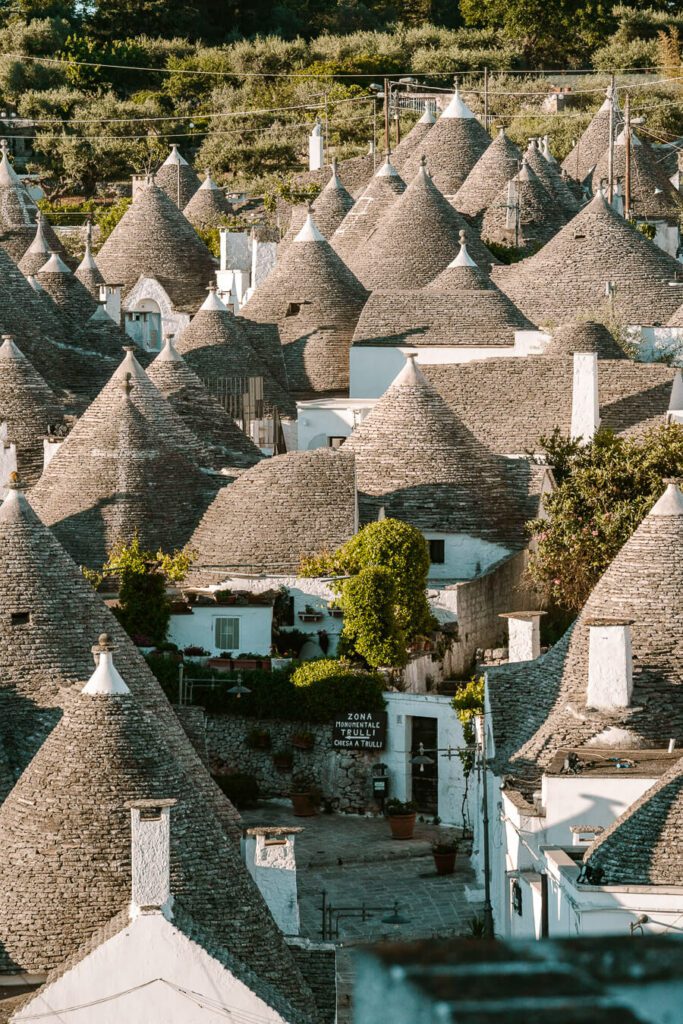
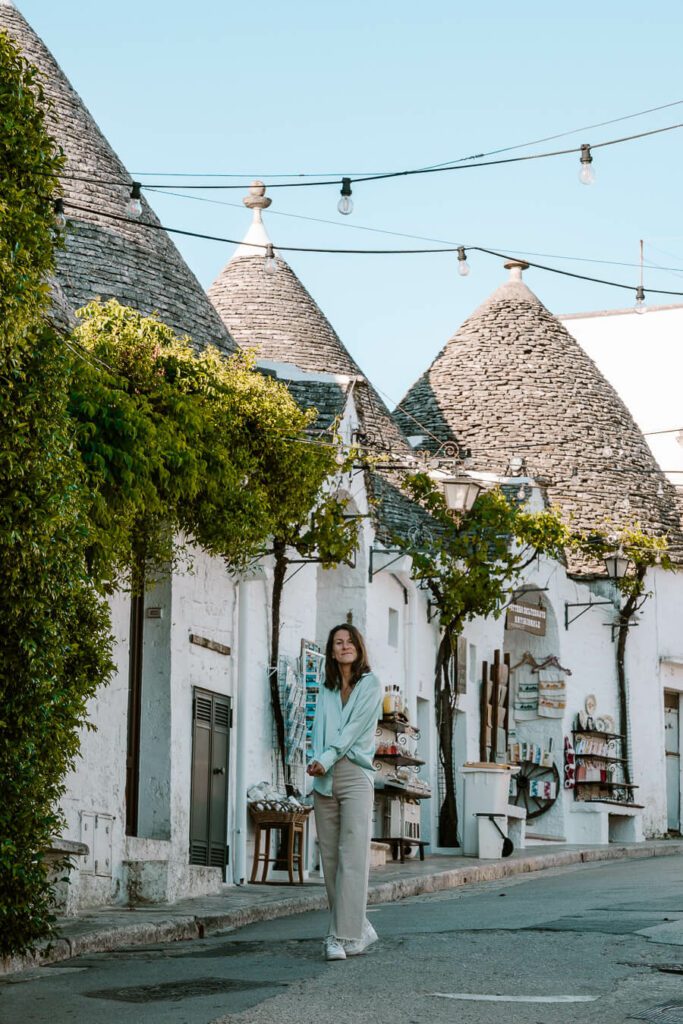
*This ‘Alberobello travel guide’ post contains affiliate links meaning I might make a small profit if you choose to book at no extra cost to you. This helps me to keep providing you with top-quality content for free.
How to Get to Alberobello Italy
Alberobello Italy is located in the Itria Valley in central Puglia, close to other towns like Locorotondo and Martina Franca. It’s one hour south-east of Bari and 30 minutes south of Polignano a Mare.
As Puglia is a supreme road trip destination in Italy, getting to Alberobello by car as part of a Puglia road trip itinerary is the best way to get here, but other ways exist too.
Car – Located in the heart of the Itria Valley, Alberobello can easily be reached from Locorotondo, Martina Franca, Cisternino, Polignano a Mare and Bari by car. Once in Alberobello, you find many places to park, including paid parking lots which seem to be the most efficient place to park.
Many of the parking lots are free before 9 am and as getting to Alberobello early to beat the crowds is a must- you’ll also get free parking. We parked here which has a great location close to everything.
Train – There are train services that run to Alberobello Puglia but the ease of the trip will depend on where you’re coming from and you’ll most like have to change trains at least once.
There are direct services from Locorotondo. From Bari, you’ll need to change in Putignano and services take about 2 hours. From further popular destinations like the Amalfi Coast and the Cinque Terre you’ll probably want to opt for the train but be prepared to have to change trains. Check Tren Italia here to plan your route.
Bus– Alberobello can be reached by bus from most towns in the Itria Valley and beyond. From Bari a bus runs to Alberobello taking just over an hour, making it more convenient than the train.
Top Things to Do in Alberobello Italy
Want all these recommendations plus the best restaurants, hotels and practical info all on your phone in one place? Get our Puglia Map here, the only resource you need for insider travel info to Puglia at your fingertips.

This lovely town is easily visited on an Alberobello day trip from other parts of the Itria Valley. In fact, Alberobello is so small you really need just a few hours to see it all.
However, seeing Alberobello at night and spending the night in a trullo in town is a magical experience I recommend.
Explore the Trulli-filled Center
Visitor’s main draw to Alberobello are its unique trulli (singular is ‘trullo’) and if this is the case for you, you’ll want to start your day by simply strolling around the centre, getting your bearings and admiring the unique architecture.
From the town’s main thoroughfare, you’ll notice the cluster of trulli and the alleyways running uphill- Rione Monti- this is a great place to start.
Every corner of these labyrinth, trulli-lined alleyways is photogenic, with entranceways decorated with cacti and potted flowers.
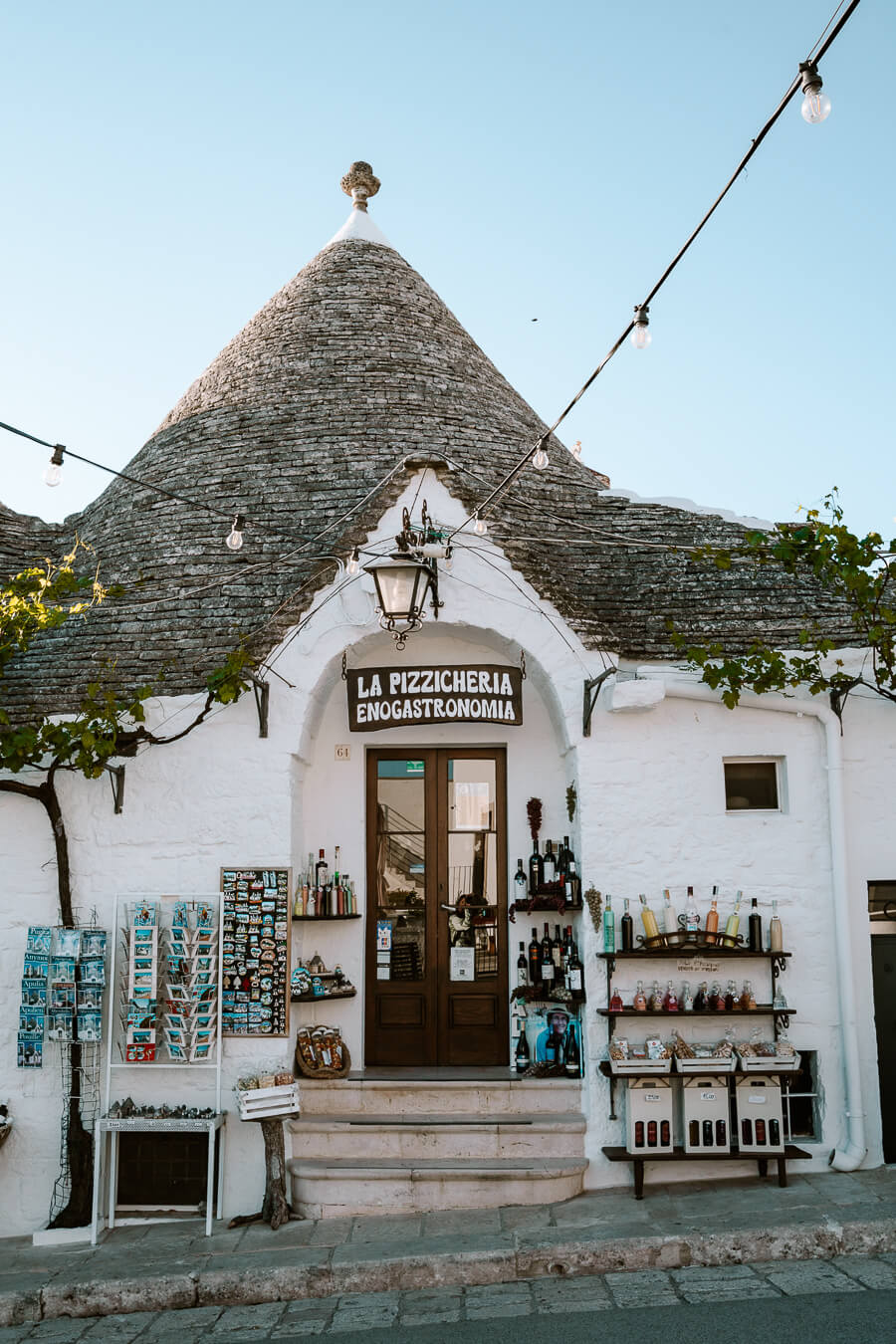
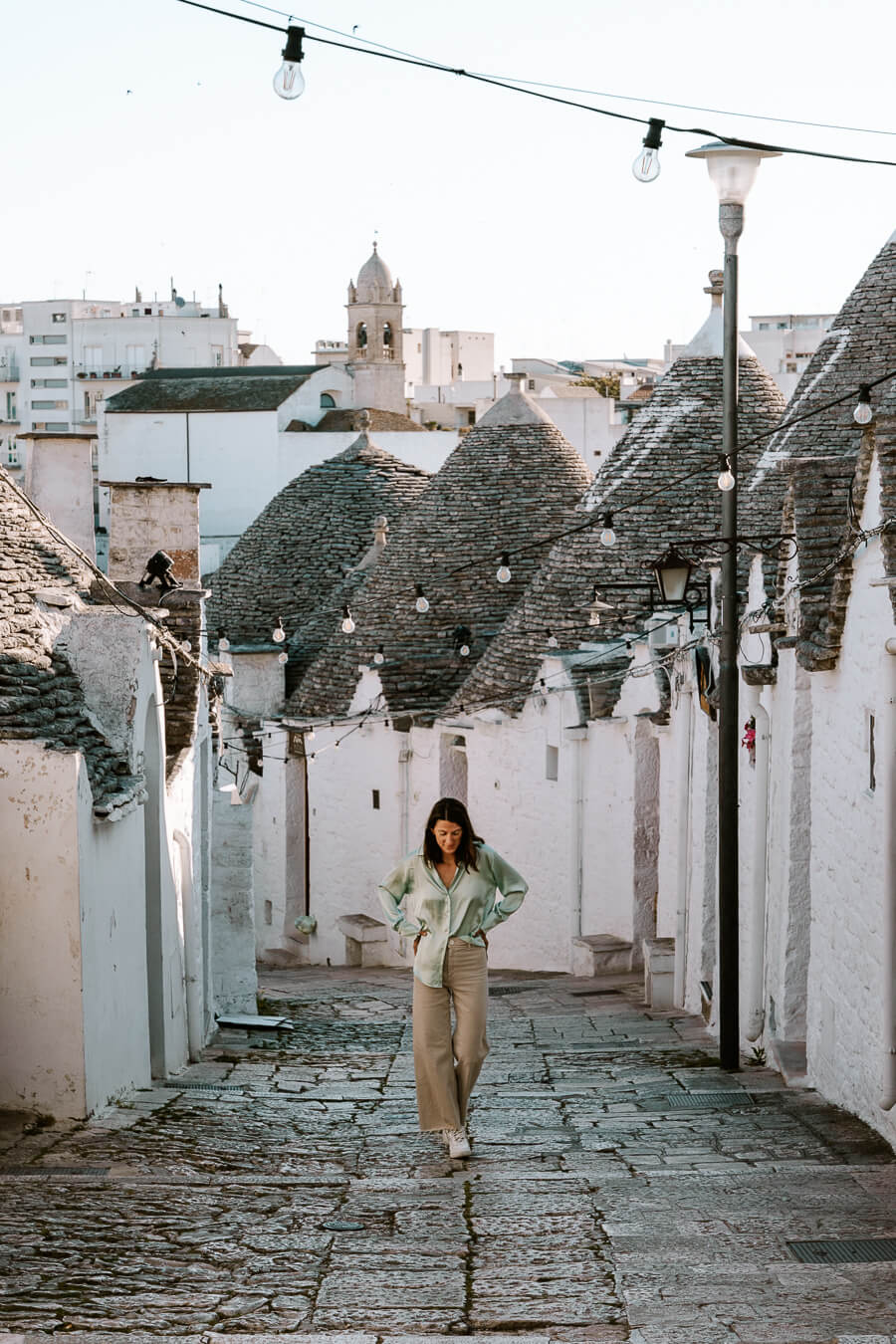

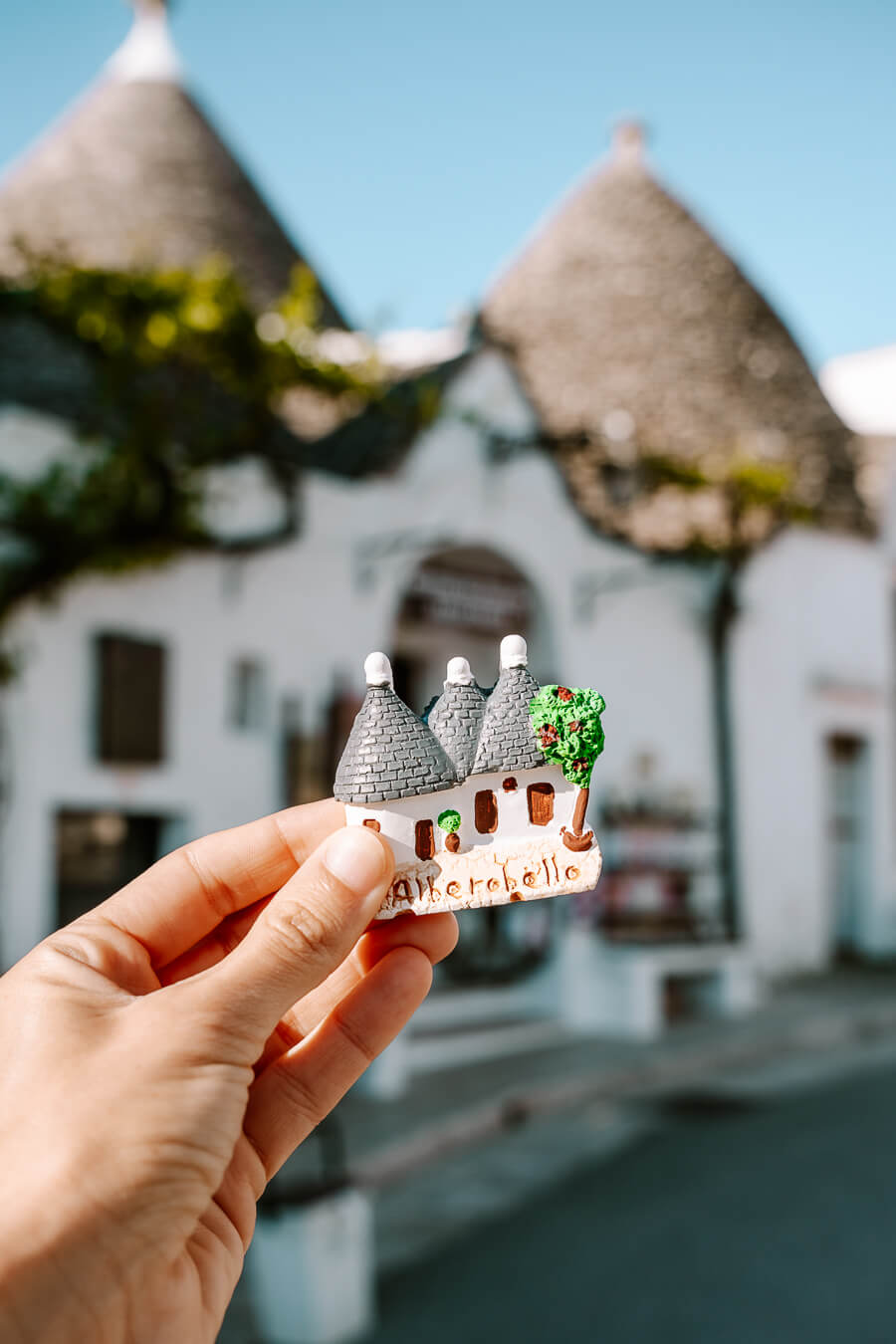
Most of the trulli here have now been converted into souvenir shops, bars, restaurants and vacation rentals but exploring a little further from the center you may find a few locals that still live in these tiny, stone, houses.
Once done in this area make sure to also cross the main road into the other side of town. There are many other trullo-filled areas to explore as well as the more modern, working-side of town where you can meet locals going about their everyday life.
I highly encourage walking around and just seeing where the streets take you. Walking around and exploring really is one of the best things to do in Alberobello.
If you don’t really want to walk around by yourself and would rather also learn a little more about the history and culture of Alberobello make sure to opt for a walking tour to make the most of your trip.
This walking tour came recommended to us which also included a tasting of local olive oil.
If you prefer a food-focused walking tour click here.
Take in the Views
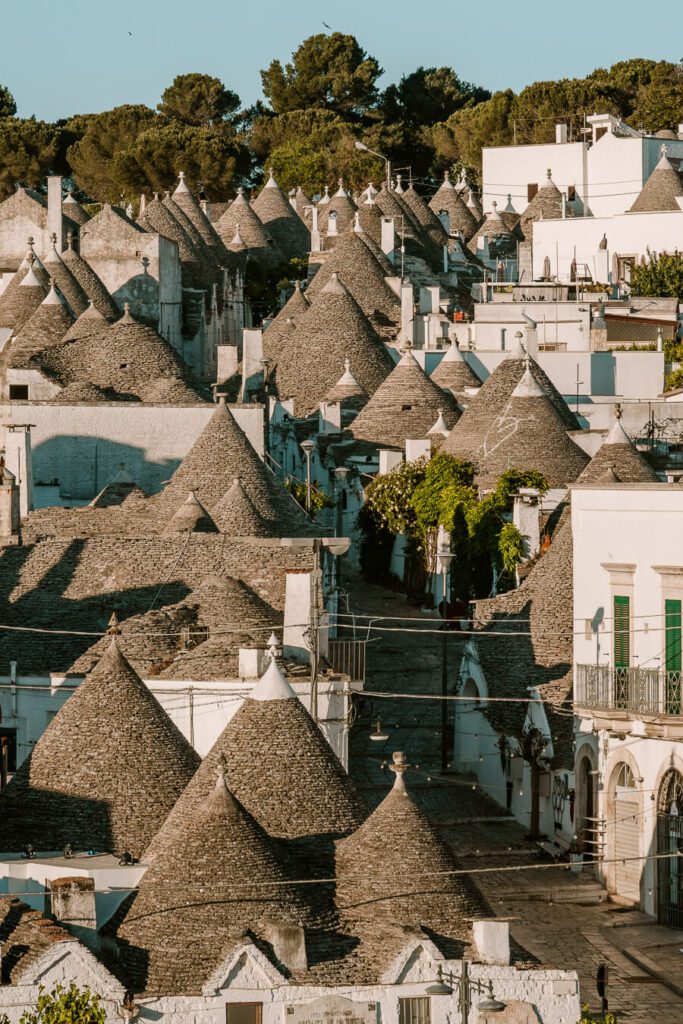
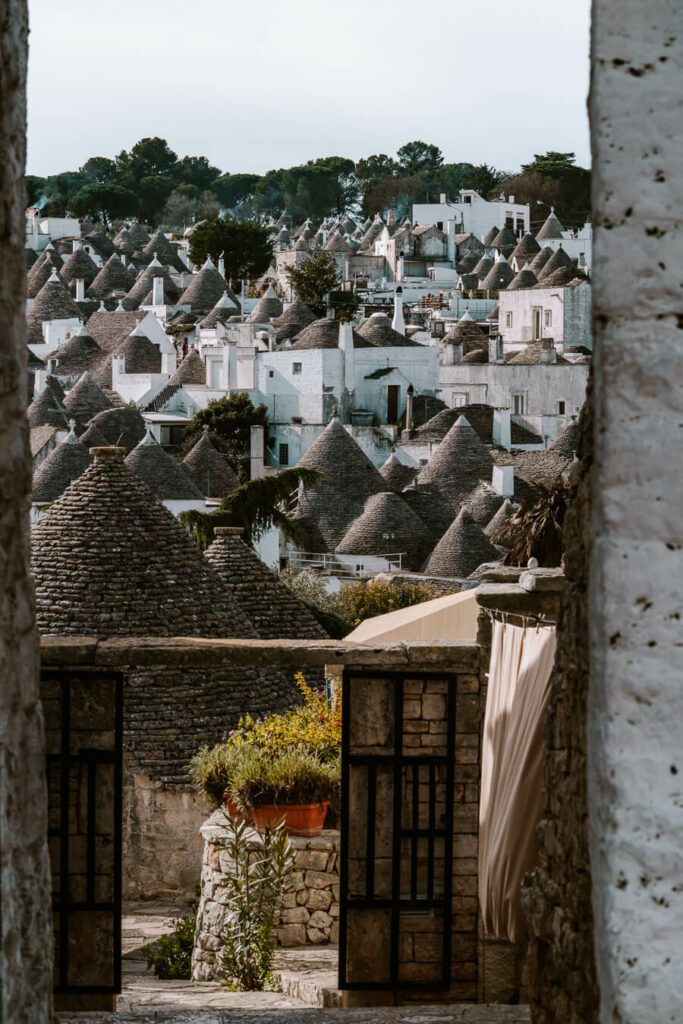
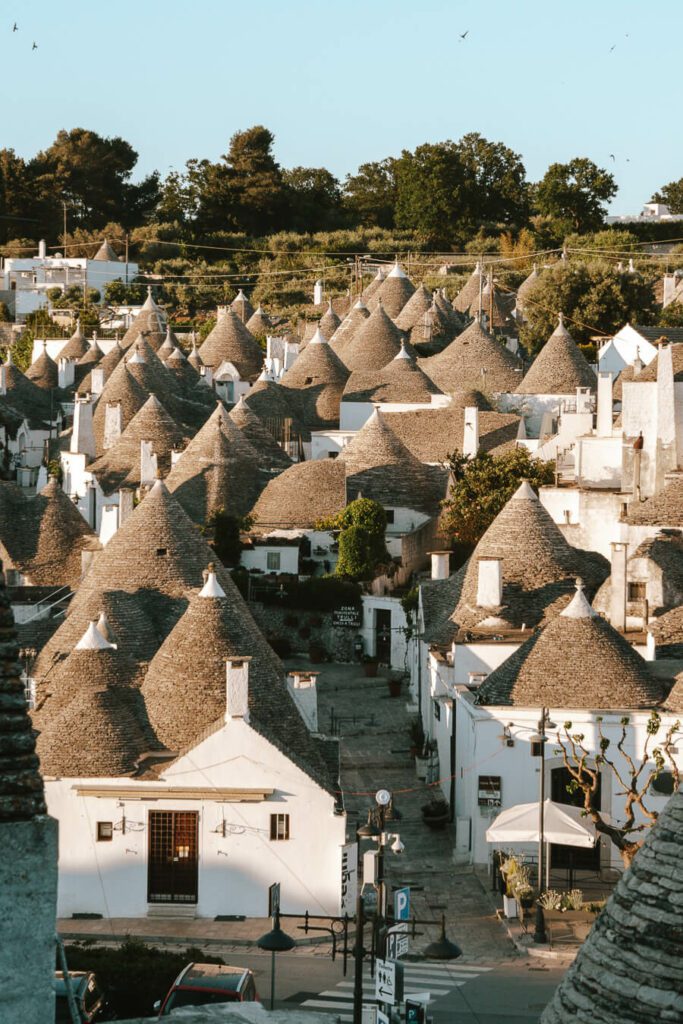
There’s nothing more unique than a panorama of Alberobello Italy, with all its white-washed, stone walls, and grey conical roofs.
Luckily there are a view different viewpoints around town that will give you a real sight for sore eyes and allow you to take some pretty dreamy photos. Here are the best viewpoints in Alberobello.
Belvedere Terrazza Santa Lucia– Right next to the church of the same name this is probably the best viewpoint in town and from where I took most of the panoramic photos in this post.
From here you can see all the trulli roofs and the little alleyways that puncture them.
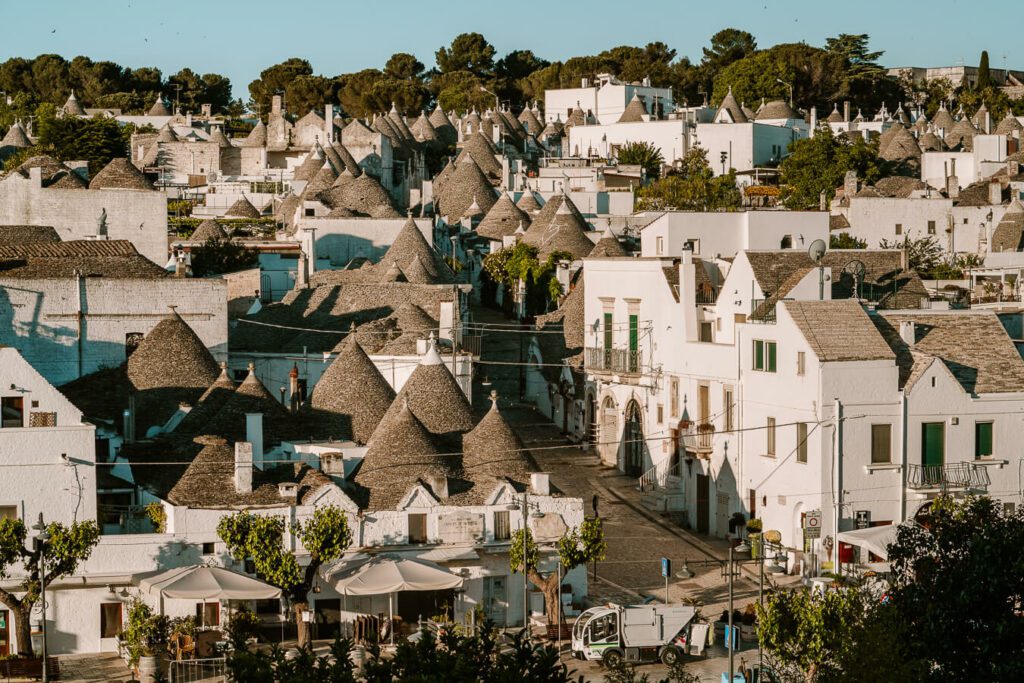
Villa Comunale Belvedere Parco – Just a short walk away from Santa Lucia church is a little communal park, perfect for relaxing and sitting down in their trullo cafe for an espresso.
This little park also boasts some spectacular views of the trulli.

Visit Parrocchia Sant-Antonio di Padova
This unique church is one of the best Alberobello attractions. For a chance to glimpse one of the largest trullo churches in Alberobello and the only thing quite like this in the world, make sure you head up to the Parrocchia Sant-Antonio di Padova.
Retaining the trullo architecture that makes Alberobello so unique this landmark church has a high, stone dome and very short nave.
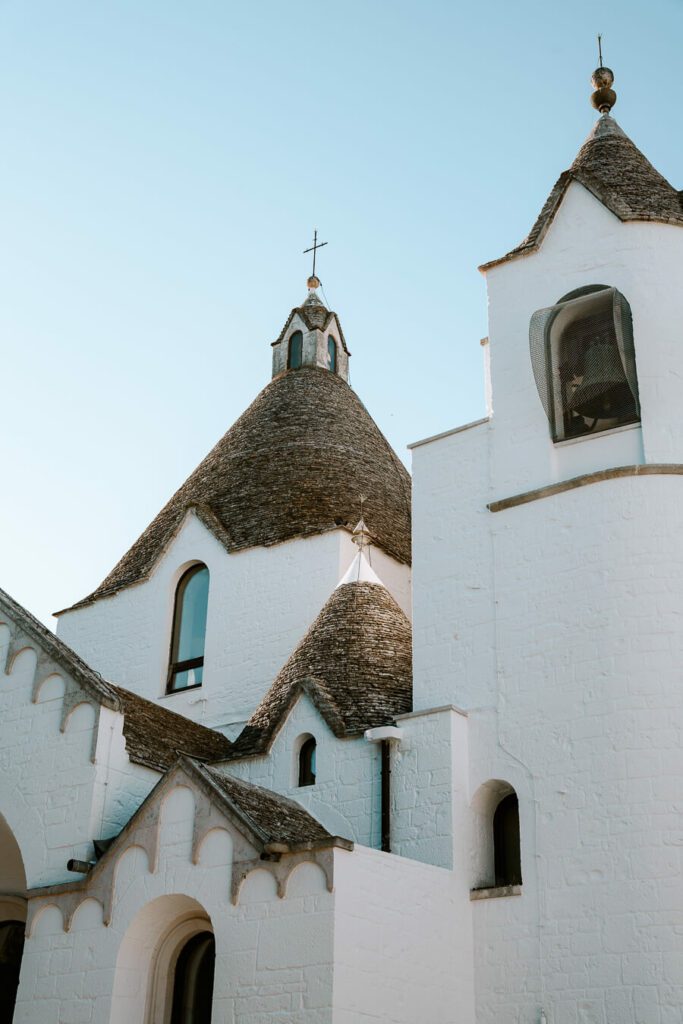
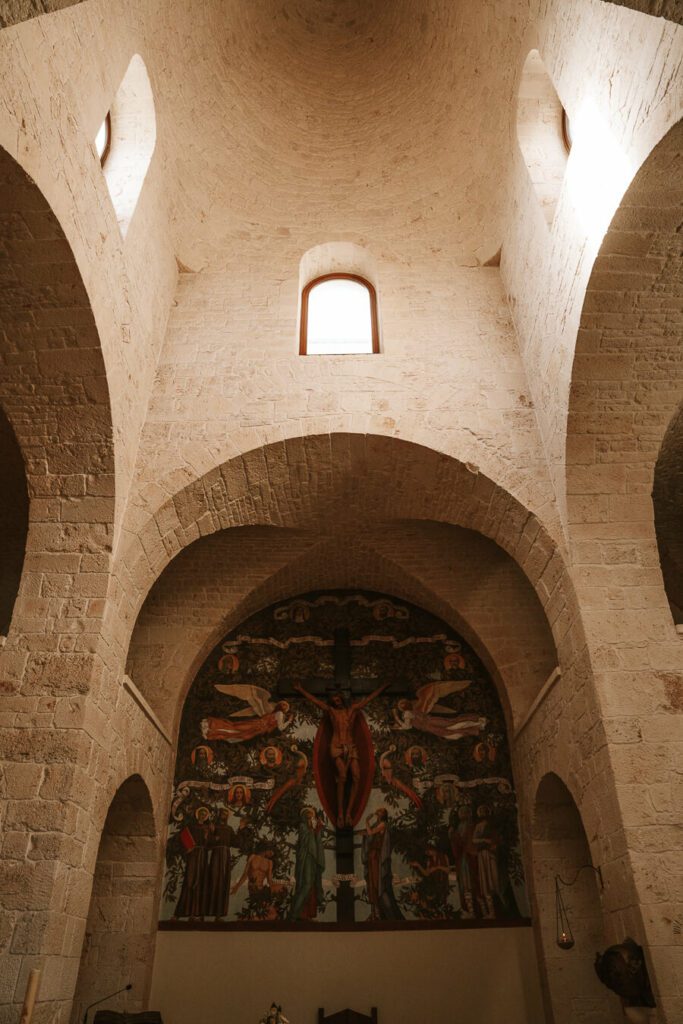
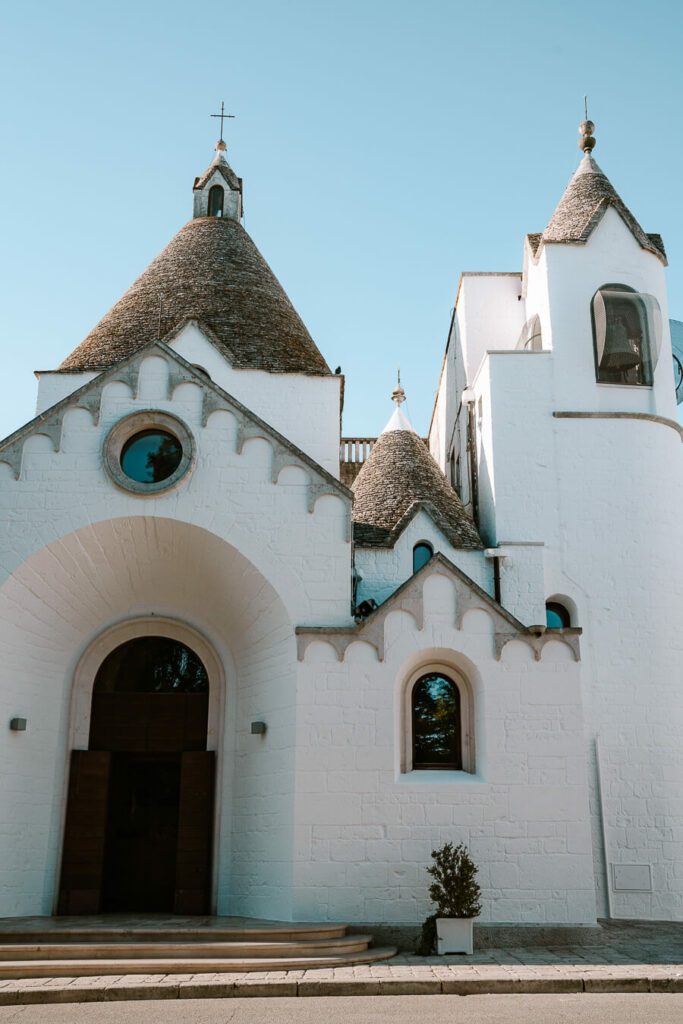
While it’s not Italy’s most well-decorated church it’s certainly worth a peek inside for its high walls and dome, not seen in the other trullo houses in town.
Stroll in the Alberobello Italy Rione Aia Picola area
While the Rione Monti area is full of beautiful trulli, it is somewhat touristy with souvenir shops around every corner. If you’re looking some something a little more authentic, taking a stroll in the Rione Aia Piccola area is one of the best things to do in Alberobello Italy.
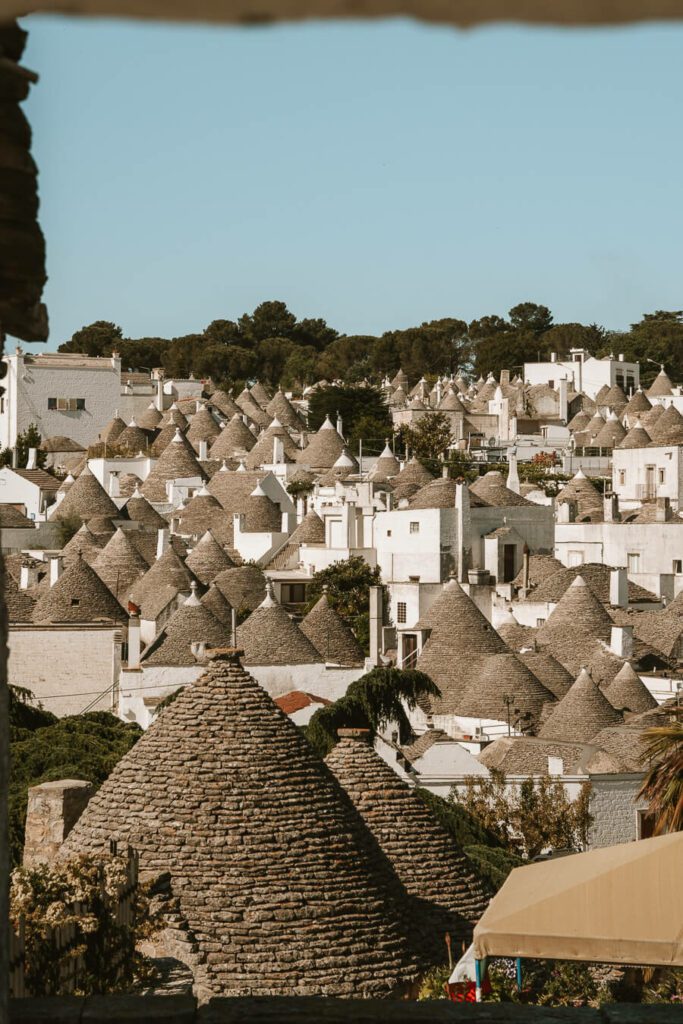
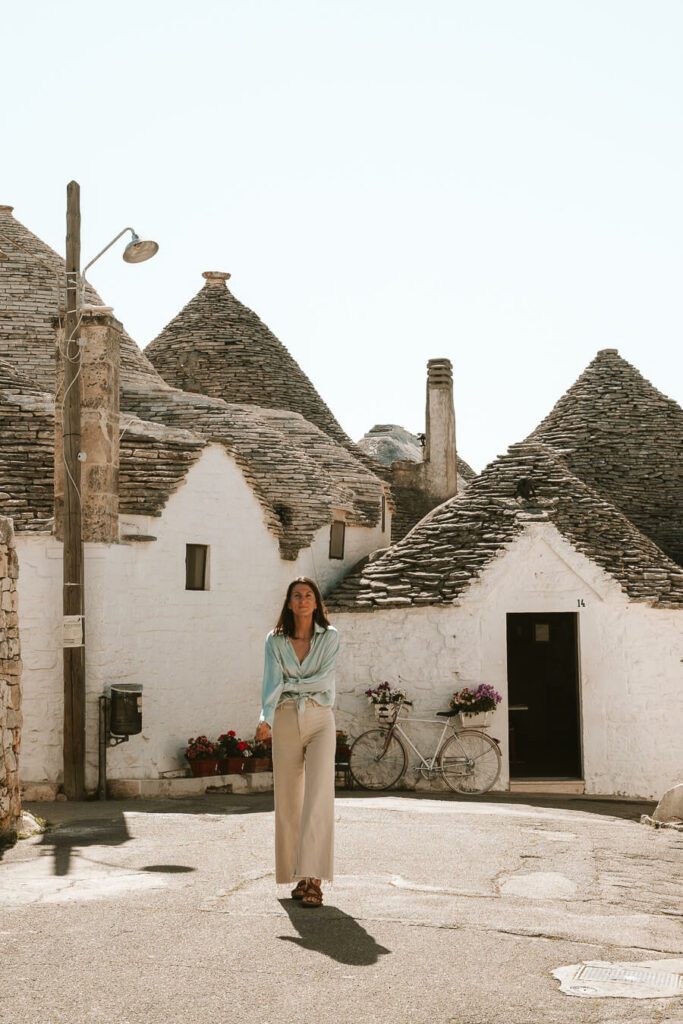
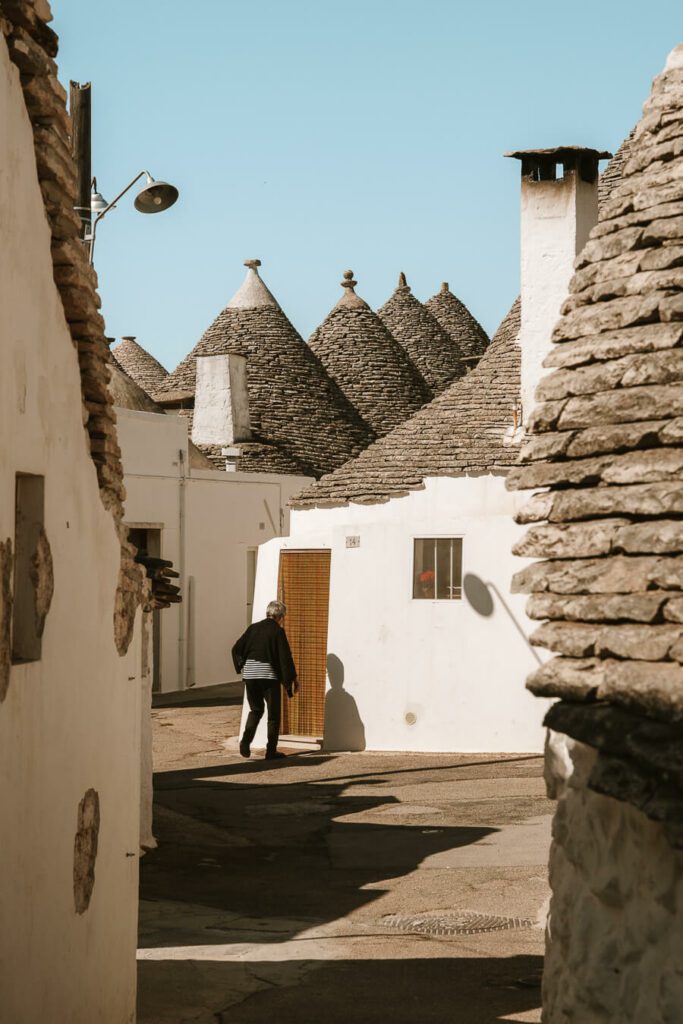
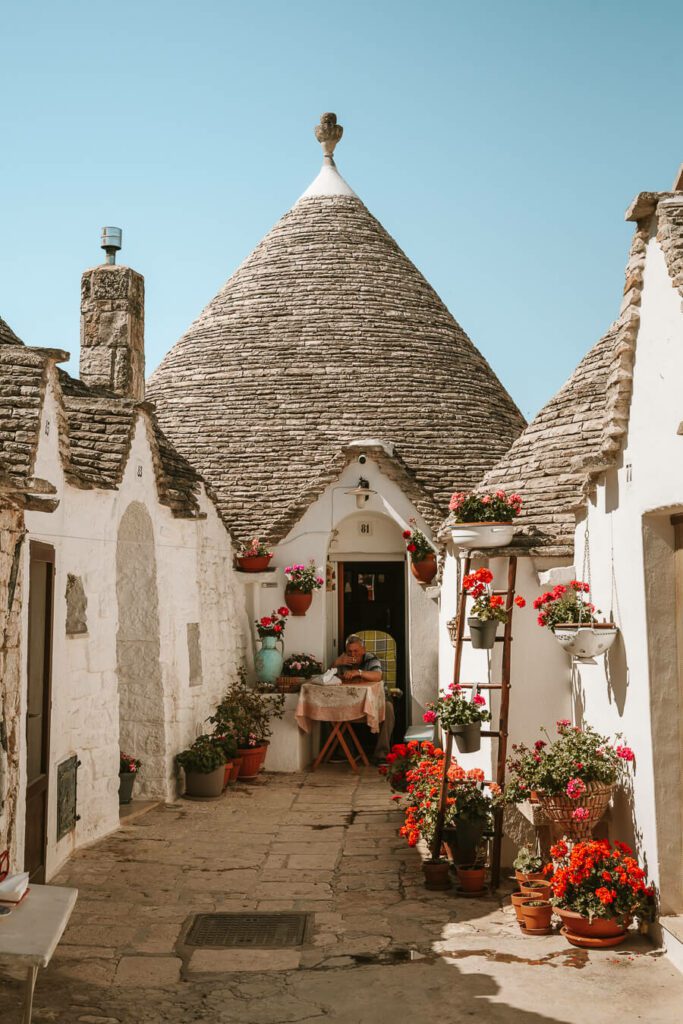
The Rione Aia Piccola area of trulli is located just east of Villa Comunale Belvedere Parco and you can find it on Google Maps here.
In this area, you’ll find much less commercialism and even a few locals that still live in these cosy dwellings. The best thing to do here is just walk around, taking any small alleyways you can find.
I highly recommend coming early as this small area gets packed with tour groups very quickly.
Visit Il Trullo Piu Piccolo
That’s the smallest trullo in Italian… this tiny dwelling is Alberobello’s baby trullo. No Alberobello guide would really be complete without mentioning it so make sure to head inside to see what it would have been like to live here.
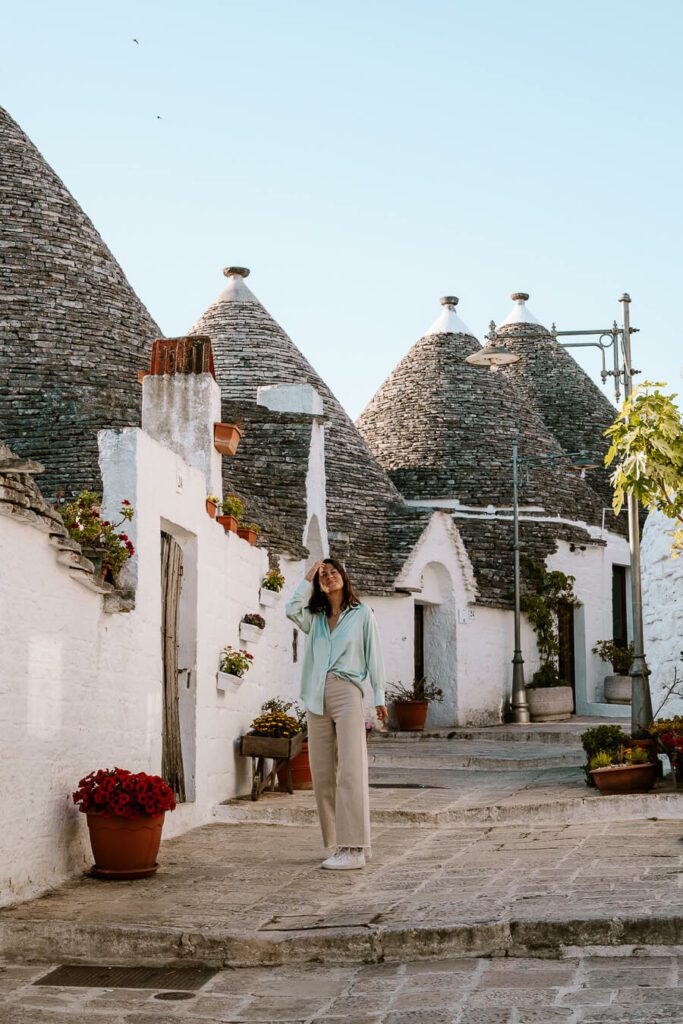
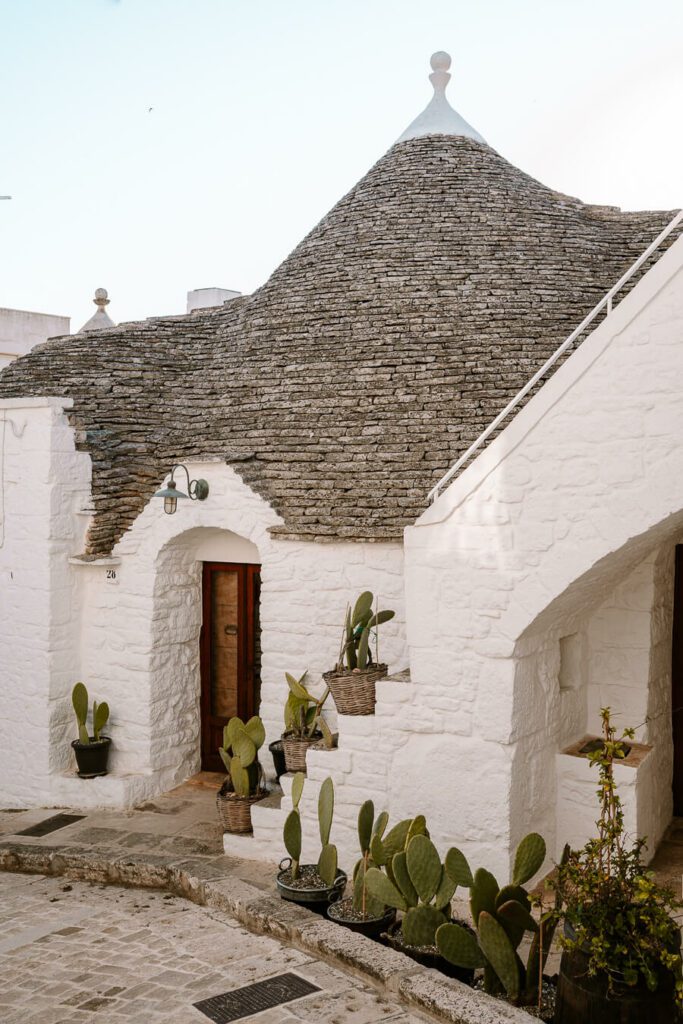
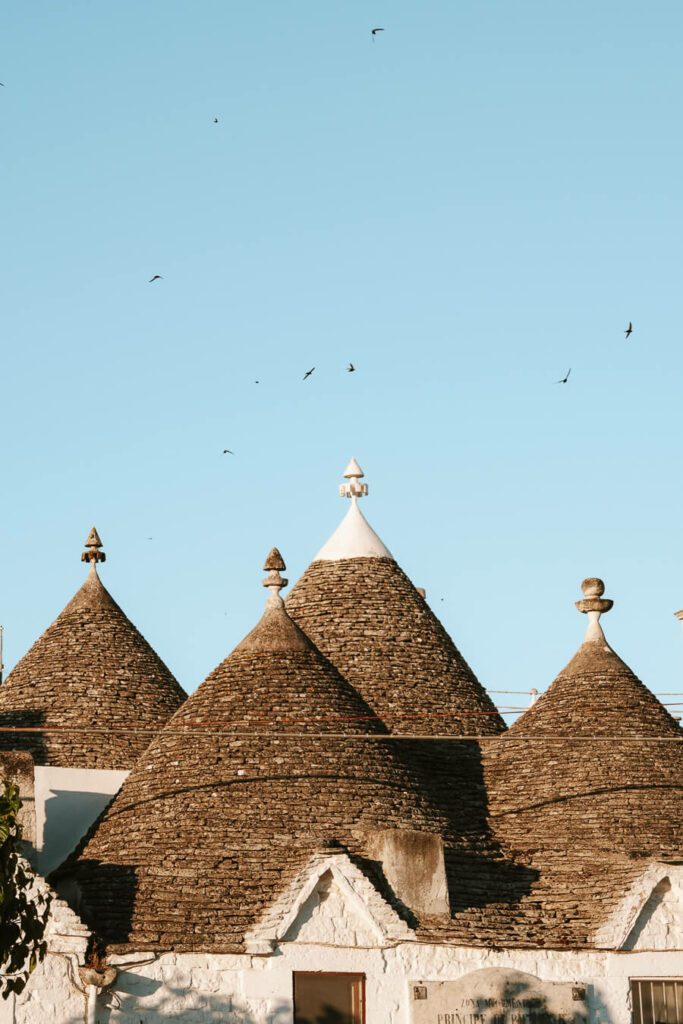
Snap a photo with a Siamese Trullo
Continuing with the theme of unusual trullos, a snap with a Siamese trullo is a must. No doubt you’ll come across the structure and potentially many more while exploring the historical town but make sure to pay attention as it’s easily missed.
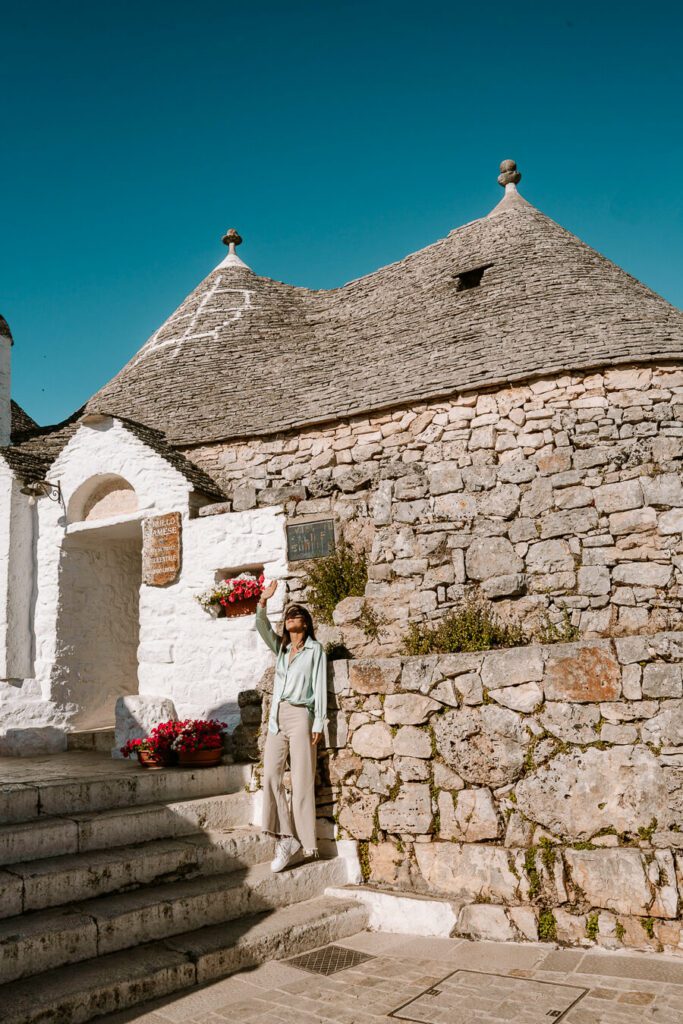
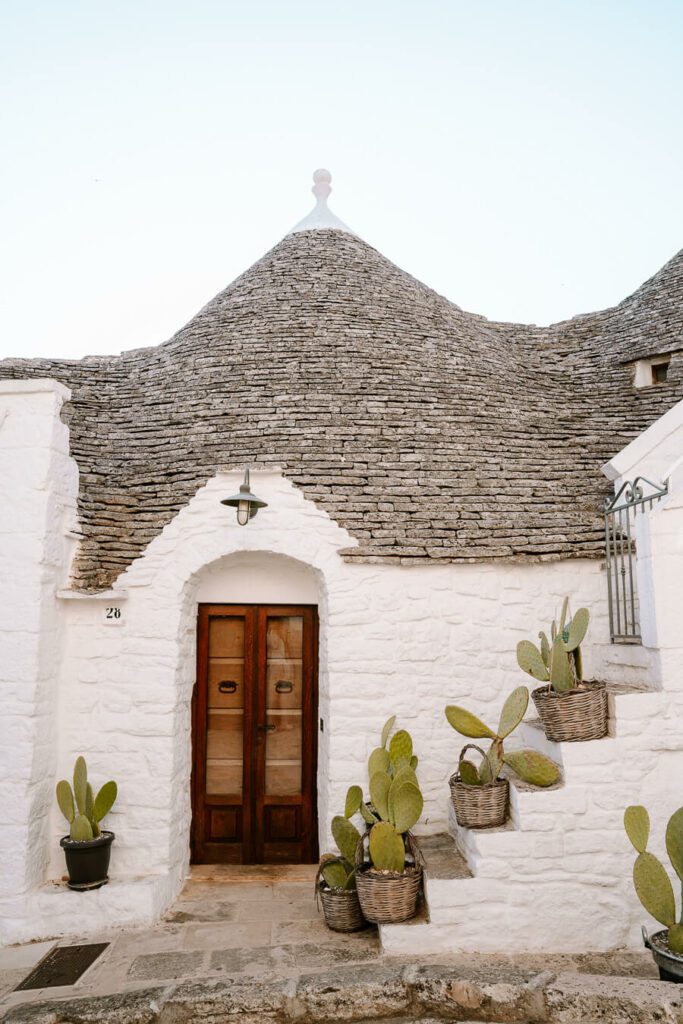
This type of two-pointed trullo may look like two trulli stuck together from the outside, but inside you’ll find just one roof.
Inside you’ll find a souvenir shop but the entrance is free if you want to go inside for a quick look. Unfortunately, it was still closed when we visited.
Visit Casa D’Amore
Throughout history, trullos weren’t exactly associated with luxurious living until the moment Casa D’Amore came about and defied the status of the trullo turning it from a humble residence to a palace.
The building of this trullo came straight after the liberation of Alberobello and shows the first architectural symbol of the liberation from the feudal vassalage of the Counts of Conversano.
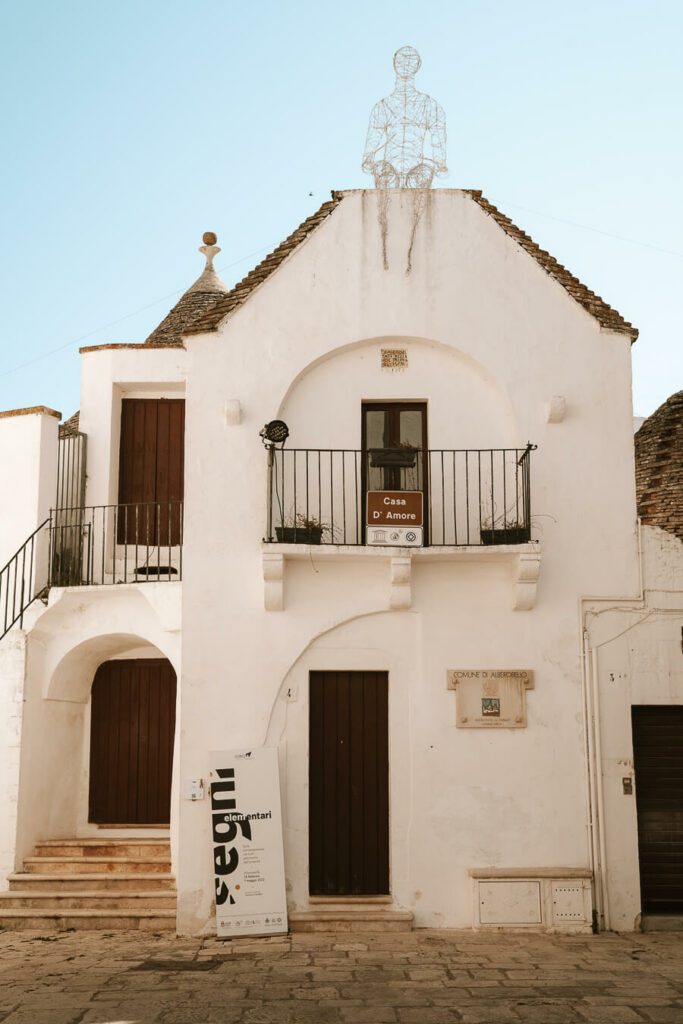
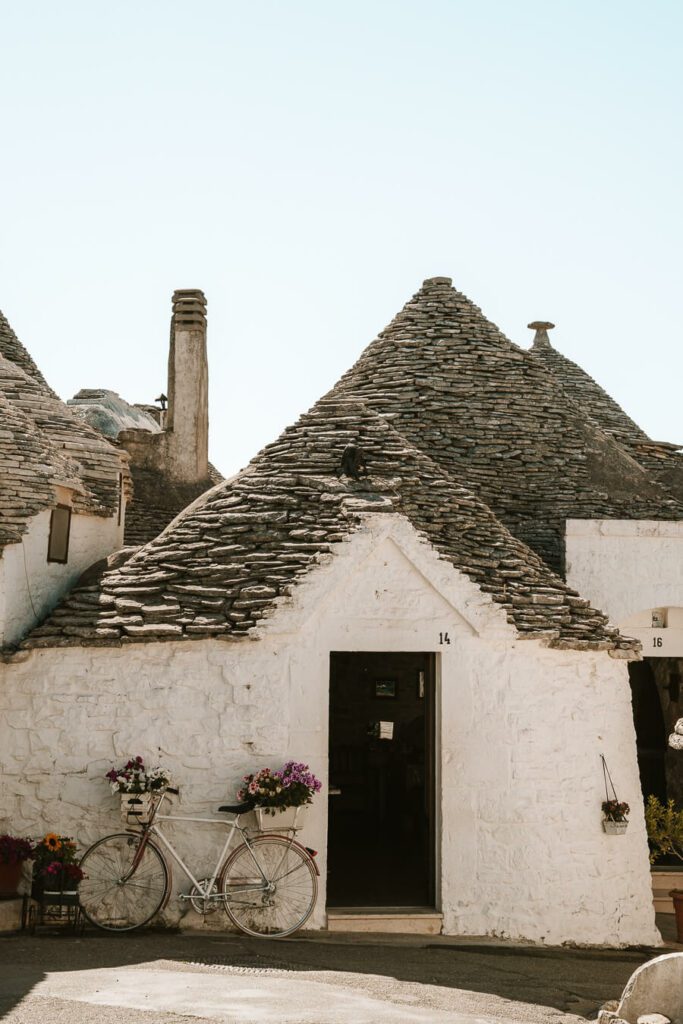
Finally, it was the first use of mortar that really allows the architecture to be able to build a ‘palace’ and add two more floors without the risk of collapse.
Casa d’Amore has had quite a few uses in its time from the residence of Francesco d’Amore to the head office of the City Council. Today it stands as one of Alberobello’s most historical and iconic buildings.
Visit the Basilica Santi Medici Cosma e Damiano
Take a break from trulli Alberobello and trullo architecture with a visit to Alberobello’s Basilica. Dedicated to the patron saints of Alberobello Italy, Cosmo and Damian, the basilica was first built in 1609 but was completely enlarged and remodelled in the 19th century in the neo-classical style.
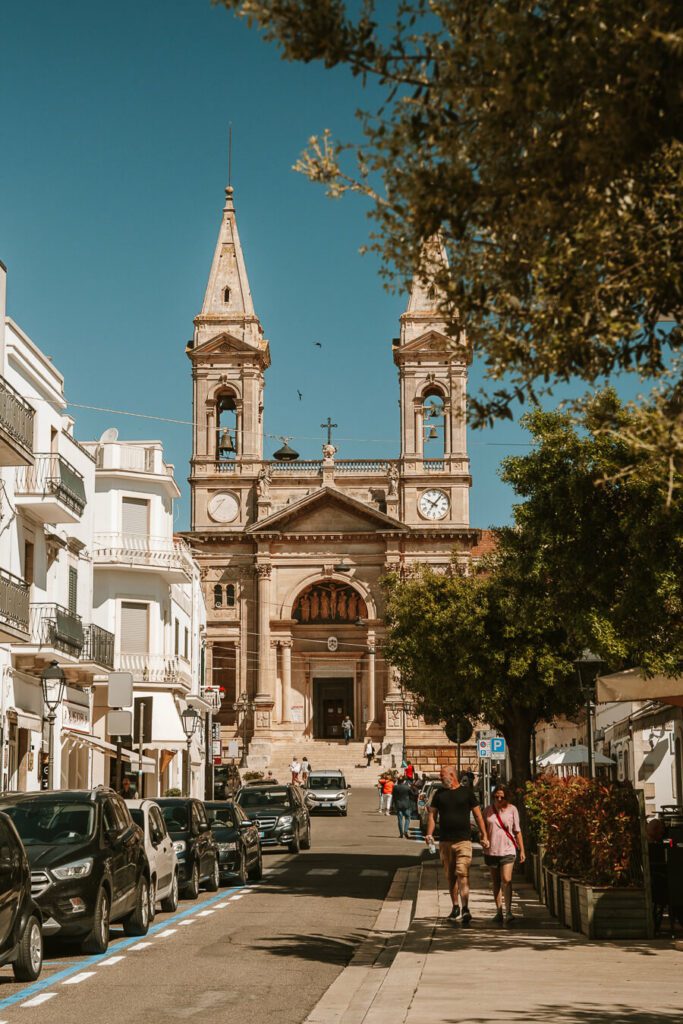
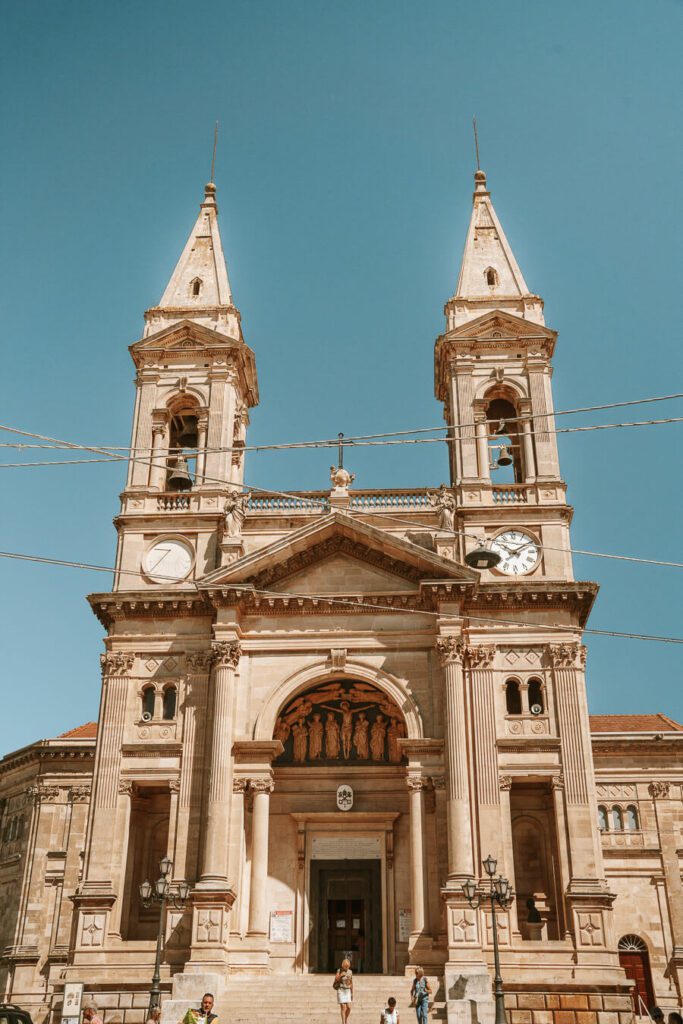
Inside, the church is white, bright and airy with a long nave and central altar. While many churches in Italy are incredible both inside and out, this one’s facade is really what impresses the most.
Learn about Trullo Living at Trullo Sovrano
UNESCO-protected Trullo Sovrano is one of the best things to do in Alberobello to learn more about trullo architecture and how people lived in them hundreds of years ago.
This is also the only trullo in town that has two storeys, making it somewhat special.
Trullo Sovrano was built in the 18th Century by a well-to-do family. They extended and added to an early 17th Century building which can be seen on the left side of the building.
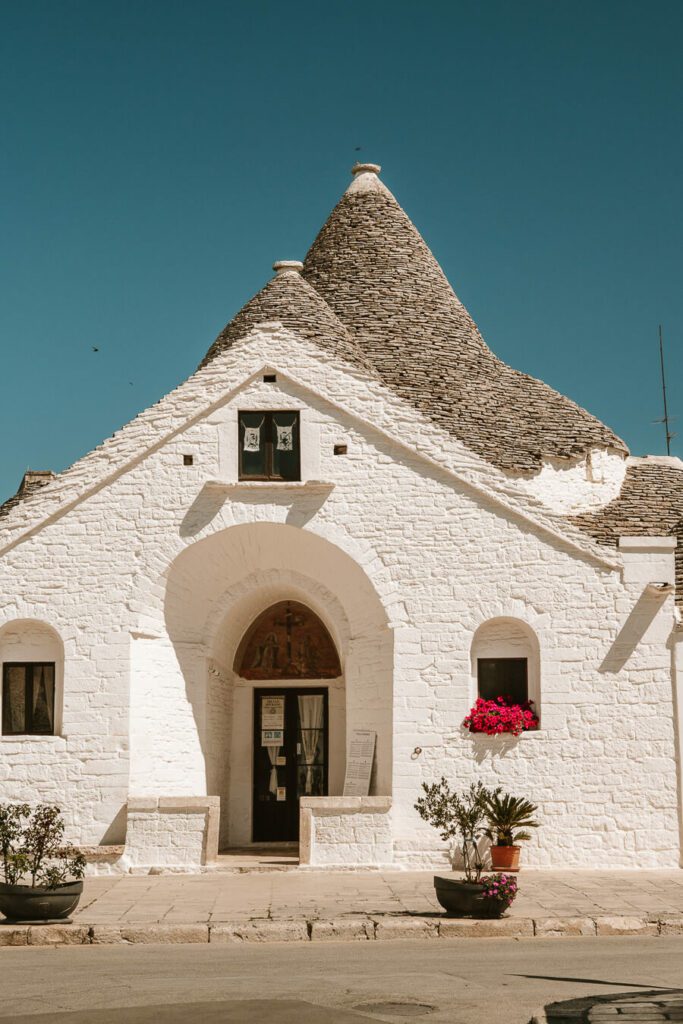
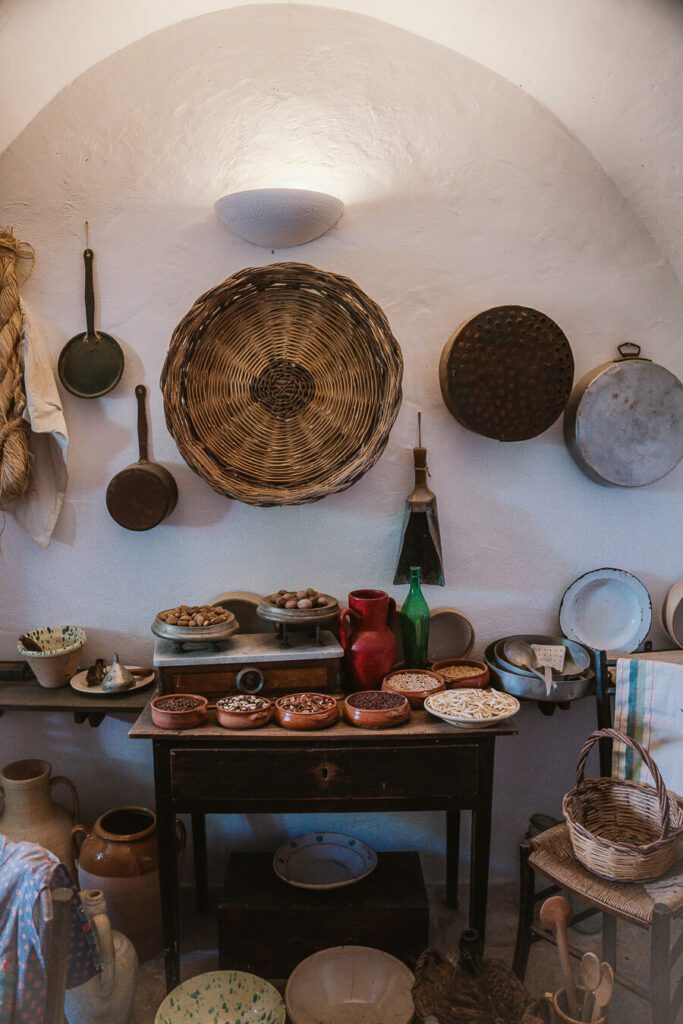
During the years the trullo has had many uses and functions including a family home, monastery, grocer, court and even home to the relics of Cosmo and Damian, the patron saints of Alberobello.
Today the trullo still belongs to the Sumerano family who has owned it for more than a hundred years.
Visiting the trullo will allow you to get a sense of the architecture from the inside and what it must have been like to live in one. You’ll also be able to see all the original furniture and decor from the 19th Century.
It’s one of the best things to do in Alberobello.
Where to Stay in Alberobello Italy
One of the best things to do in Alberobello is the opportunity to stay in a trullo yourself. Most have been remodelled to provide seriously swoon-worthy, cozy accommodation with all the mod-cons- perfect for a couple or small family.
It’s also possible to stay outside Alberobello Italy for a few nights and use it as your base to explore all the Valle d’Itria towns. This is what we did and found it much easier while on a Puglia road trip.
Suite21 – The Trulli Experience – The cutest little trullo, perfect for a couple, the modern, minimal design here is just so Pinterest-worthy.
The little holiday home consists of one main room with sofa, dining area and kitchenette as well as one or two separate bedrooms and a modern bathroom. The location in the middle of town is perfect too. Check rates and availability here.
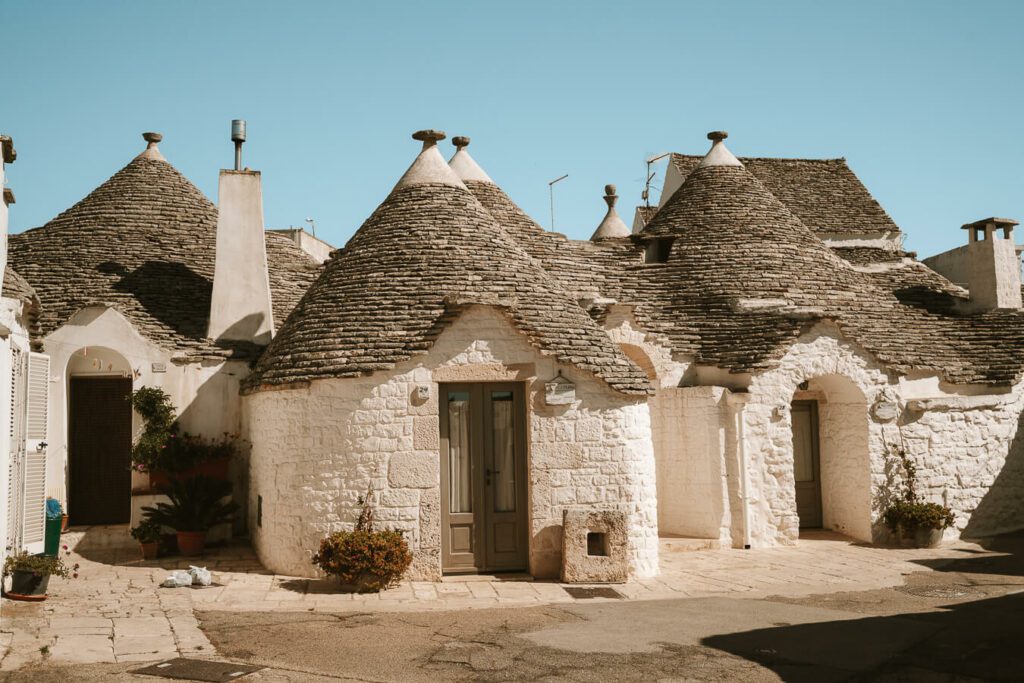
B&B Salita Delle Pere – Stay in a trullo country home in true Apuglian fashion. You can choose from a simple double room, but I highly recommend staying in the one or two-bedroom trullo for the best experience.
The breakfast at this property is also incredible and it’s located in the peaceful countryside just outside Alberobello. Check rates and availability here.
Trulli Soave – Another opportunity to stay in a beautiful trullo home. Located just off the main street in Alberobello this is perfect for those exploring without a car. The breakfast here is great too. Check rates and availability here.
Masseria Pentima Vetrana Resort – For those wanting the Puglian Masseria and trullo ( luxury farmhouse) experience this option is perfect.
Stay in a beautifully converted trullo, roam around their beautiful gardens and make sure to make the most of the pool after a day of exploring. Check rates and availability here.
Where to Eat in Alberobello Italy
Bar “Il Trulletto” – A lovely little spot with outdoor seats perfect for morning coffee and a light breakfast. They open pretty early too.
Ristorante “L’Aratro” di Domenico Laera – one of the best restaurants amid all the trulli, this very local spot has been run by Domenico Laero since 1987.
One of the best things to try is the antipasti where you’ll get served some of the best local dishes according to the season. The pasta here is also incredible.
Ristorante Il Pinnacolo – Food cannot get any more local than here. Specialising in food and ingredients from the Itria Valley, Il Pinnacolo serves classic dishes as well as olives and great wines. The setting couldn’t be better than in a trullo itself.
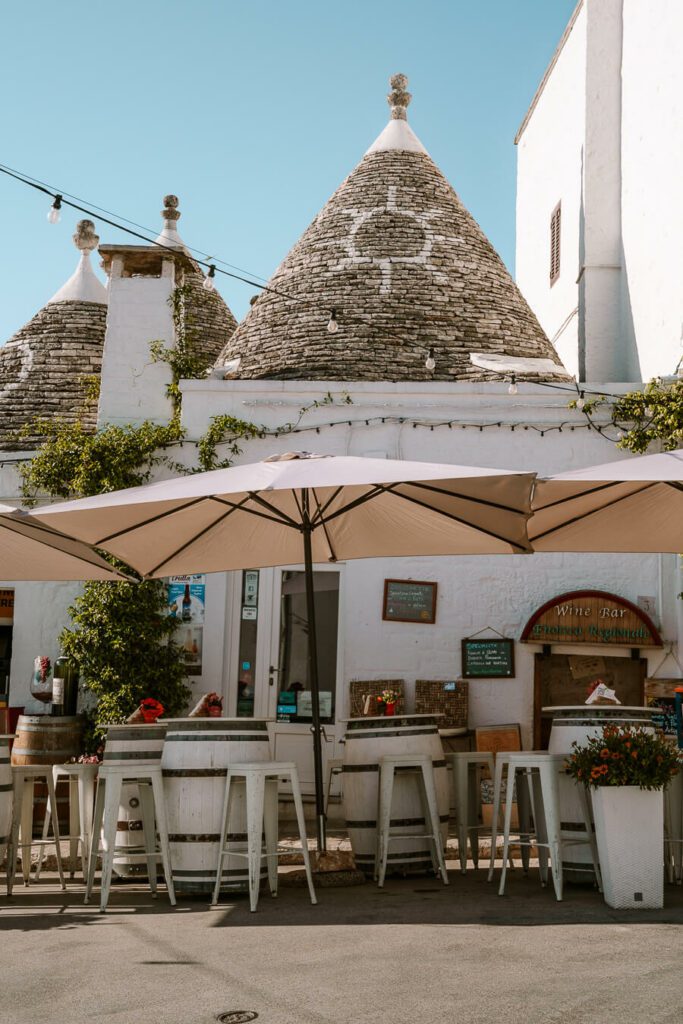
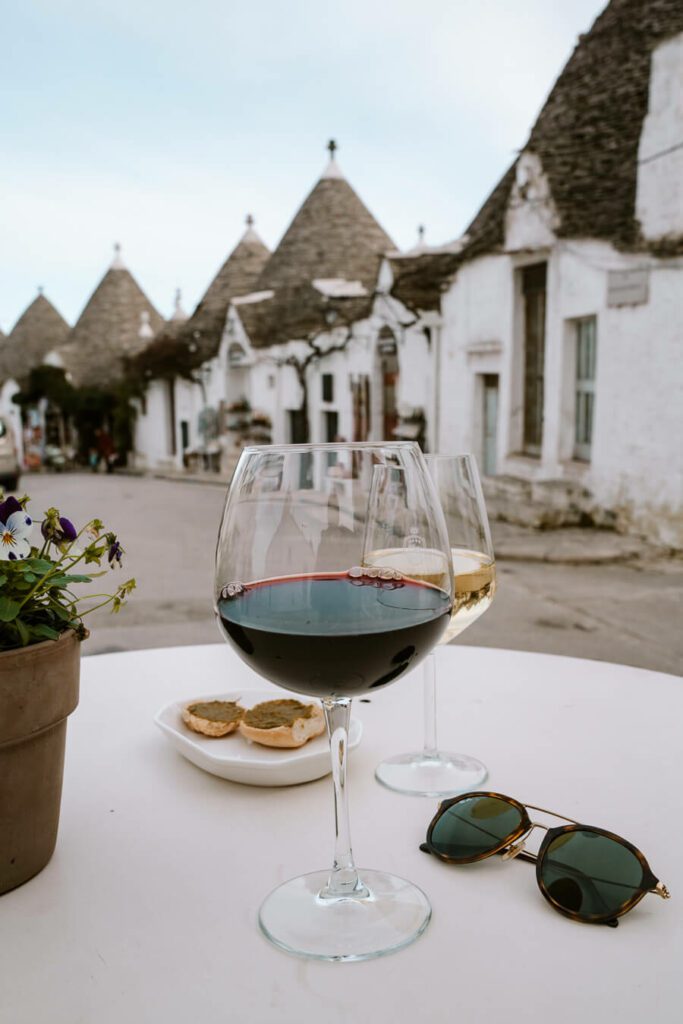
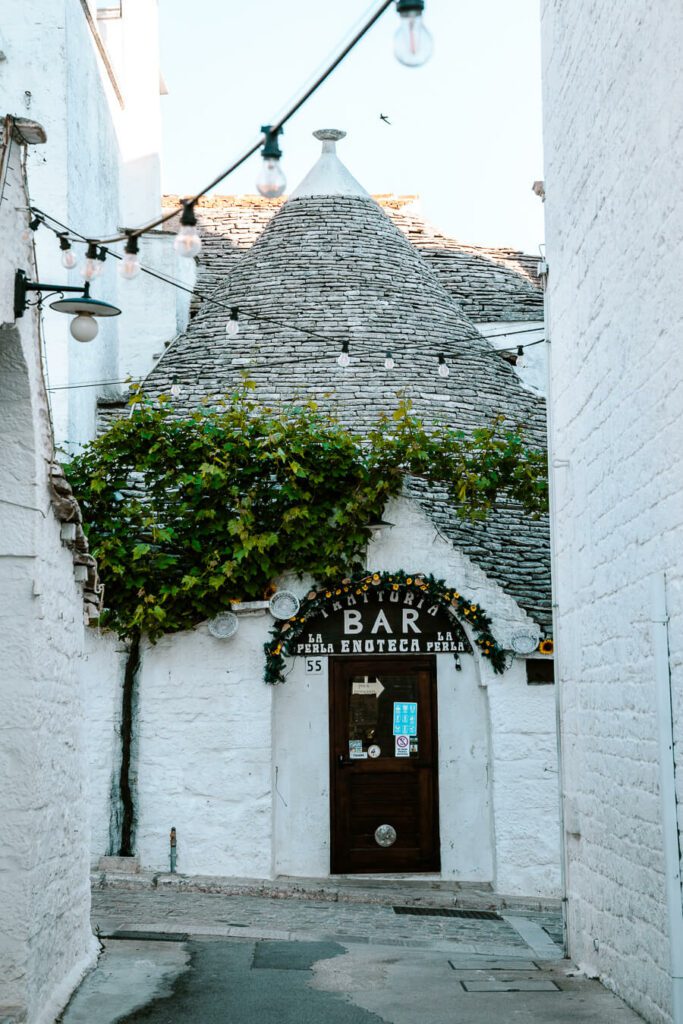
Favola in Tavola – A lovely, romantic setting, perfect for dinner, their menu isn’t big but has all the classics from the region including orecchiette in tomato sauce, mashed fava beans as well as a lot of meat and fish dishes.
Trulli e Puglia Wine Bar – One of the best and most atmospheric spots for some wine and antipasti. They also do wine tastings where you can sample the best regional wines. This is the perfect spot for a bit of wine after an afternoon of exploring.
If you’re a foodie you can also sign up for this Market Tour with Cooking Class and Dinner to experience more local food culture.
For all these and more restaurant recommendations in Alberobello and beyond, download the Puglia Map today– it’s all you need for the best insider recs in Puglia.

Read more: Unmissable Wineries in Puglia for Your Next Trip
Top Tips for Visiting Alberobello Italy
↠ Come early! The early bird gets the worm, right? That could not be more true for visiting Alberobello.
Alberobello is the Itria Valley’s most famous little town and it gets really crowded and feels so with all the small and narrow alleyways of the trullo-lined streets. It’s also really popular with bus-loads of tour groups.
To have the place to yourself, and to escape the heat, I highly recommend getting here before 8 am.
↠ For reasons related to crowds and heat try to visit Alberobello and the whole Puglian region outside the high summer months of July and August. We went in May and it was delightful.
↠ Alberobello is very small and can be seen well in just a morning. We arrived at 6.30 am and left by about 10.30 am. You can spend the afternoon exploring Locorotondo, Martina Franca, Cisternino or even Ostuni, Polignano a Mare or Monopoli.
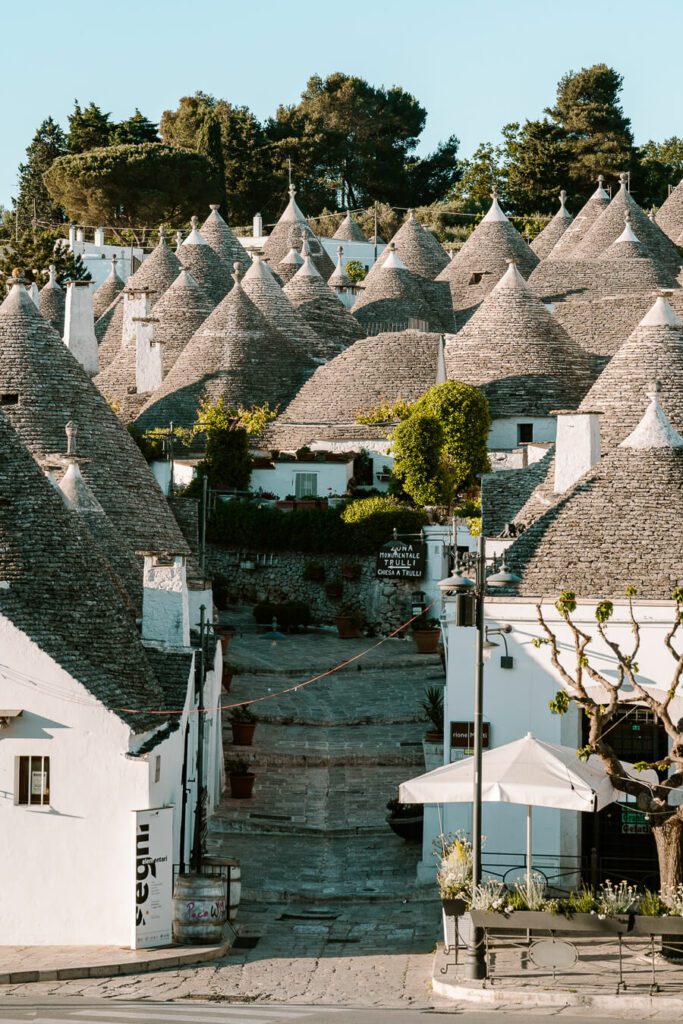
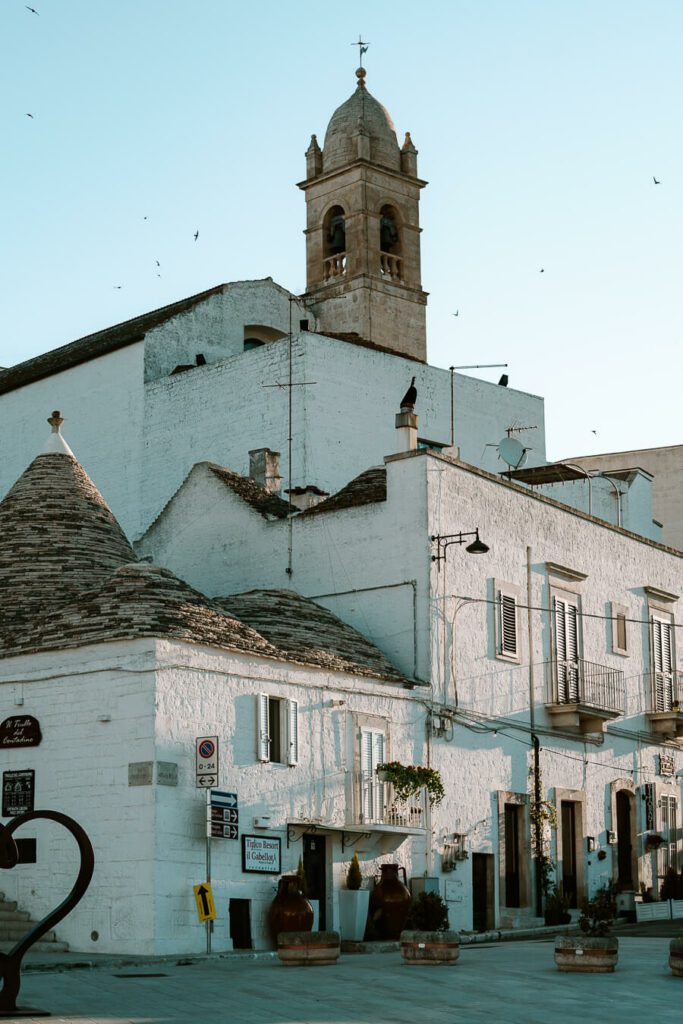
Is Alberobello Worth a Visit?
The short answer is yes absolutely!
Even though it does get extremely busy and it’s commercialised, touristy and no longer very authentic it’s still worth a visit.
Simply put, you won’t find this architecture anywhere else in the world. I’d highly recommend visiting for a short time, very early in the morning to avoid all the crowds and gift shops.
With nobody around at 6 am and with the golden light casting its rays over the conical roofs, this place is magical. An Alberobello tour is also a great way to experience the magic of this small town in Puglia.
Are you ready to explore the best things to do in Alberobello Italy? Let me know your questions and comments below, I’d love to hear from you.
Now more than ever, make sure not to leave home without travel insurance. For the last few years, I’ve been using Safetywing Nomad Insurance for all my individual trips and digital nomad lifestyle and there’s no better company for all my insurance needs. Cover starts from as little as $42 per month. Get your quote below now.
Planning a trip right now? These are just some of my favourite websites I use to book everything from hotels to rental cars!
Rentalcars.com and Discover Cars for quick and easy car rentals worldwide
Booking.com for great deals on hotels
Agoda also for great deals on hotels
Get Your Guide and Viator for tours and adventures around the world
Related posts you might like:
Visiting Cisternino Puglia: A Curated Travel Guide
Top Things to Do in Bari Italy | A Perfect Stay in Puglia’s Capital
A Weekend in Polignano a Mare, Puglia: The Definitive Guide
Polignano a Mare Beaches: Uncovering the Resort Town’s Top Beaches
FOUND THIS ALBEROBELLO ITALY POST USEFUL? PIN IT AND SHARE
